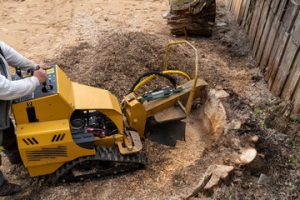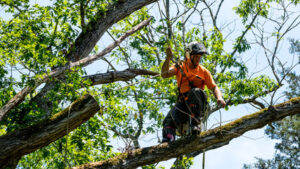Trees can be a beautiful addition to your property, but there are times when they become a nuisance or hazard. For instance, dead or damaged trees may fall and cause damage to homes and structures.

This is when Tree Removal Irvine CA becomes necessary. It is a process that requires careful planning and precision to ensure that everything around the tree remains safe.
Tree removal can be a complex process that involves careful consideration of the landscape, local regulations and environmental impacts. The process requires expert arborists with a thorough understanding of the tree’s condition and its surroundings.
Many homeowners decide to remove trees that are a hazard due to their health, location or structure. Oftentimes, this involves removing trees that are leaning precariously or that are too close to structures and power lines. Some trees are also removed for safety reasons if they show signs of structural failure like large cracks and rot.
In some cases, the need for tree removal may be triggered by the presence of harmful pathogens or pests. These organisms can spread to other plants and threaten their health, making it necessary to remove the affected trees. In addition, overcrowded areas can benefit from the removal of excess trees, allowing other plants to flourish and improve the overall health of the landscape.
Occasionally, the need for tree removal is prompted by new construction projects in urban or developing areas. When a construction project interferes with the growth of trees, it may be necessary to remove these trees to prevent interference with building foundations and utility lines.
Homeowners may also decide to remove trees that are a hindrance to the enjoyment of their properties. For example, if a tree is obstructing the view from a house, it may be necessary to remove it to make room for landscaping features like a pool or firepit.
The need for tree removal can be a complicated and significant decision that should be made only after careful consideration of the landscape and surrounding environment. The expert arborists at Panorama can help property owners identify whether a tree is in need of removal and recommend the best course of action. In addition, our post-removal services include stump removal, soil remediation and replanting with appropriate species to maintain ecological balance. Contact us to learn more about our tree services. We look forward to helping you create the beautiful and functional landscape of your dreams!
Felling
Professionals use specialized equipment and safety measures to remove large, dangerous or ill-placed trees. They start by assessing the situation, planning the safest way to cut the tree down and then carrying out that plan with precision. For example, they may need to set up a safety perimeter around the tree and install barriers to protect people or property from falling debris. They also ensure that the tree falls in a safe direction.
In addition, they might need to climb the tree or use rigging to cut and lower sections of the tree. This is especially common when the tree is too large to be felled or when it’s in a hazardous location, such as near power lines. Climbing can be safer than felling because it prevents limbs from falling onto workers and damaging equipment or vehicles. It can also save time because it’s more efficient than cutting a tree down in pieces, but it’s still risky work.
It’s important to note that some regions have laws that require permits for removing certain types of trees. If a tree is in a protected area or falls within an urban canopy, for instance, it might be subject to special rules that must be followed to avoid fines. Licensed and experienced tree services know the rules for their jurisdictions and can quickly navigate the permit process.
Some services specialize in removing both the tree and its stump, which is often left behind after a removal. This service is known as stump grinding or stump removal, and it can be performed either in conjunction with the felling of a tree or separately. For larger stumps, a crane can be used to pull them out of the ground. This method can be more efficient and safer than using chainsaws, but it’s important to have a solid plan for dealing with the resulting green waste. For example, some services will chip or grind the resulting green waste while others might take it away for processing or disposal.
Stump Removal
When a tree is cut down it leaves behind what is known as a stump. This is the section of trunk that remains buried in the ground, along with roots. If left untouched, the stump and roots can rot. This can attract unwanted pests and fungi into your yard. Leaving a rotting stump can also cause problems to underground water systems, pipes and even your home’s foundation. Removing the stump is essential to prevent these issues.
Stump removal can be done through a number of methods, including burning or dissolving with chemicals. However, these options are often not very effective. They can be quite costly and require heavy machinery to be used. Also, they can create a mess with wood chips or soil strewn around your yard. Alternatively, you can choose to dig out the stump and roots through manual labor. While this is more time-consuming and labor intensive, it does eliminate the need for chemical intervention and leaves you with a clean slate that can be replanted to your liking.
One option is to use a commercial stump remover or plain old saltpeter (aka potassium nitrate) to burn the stump. This process can be very messy and requires a lot of patience to get it right. Before proceeding, make sure you have the proper safety gear in place such as a hard hat and work gloves. Also be sure to check with the local fire department regarding open burning laws.
The first step is to sever the roots with a hand saw and then use loppers to chop them up into smaller pieces. You can use an axe at this point if the stump and roots are particularly stubborn. Once the stump and roots are a good size, you can start to dig them out with a shovel.
Another option is to use a stump grinding machine to grind down the stump to below ground level. This is a great option to consider if you have the right equipment and have the time to supervise the operation. The stump is then covered with a plastic tarp and a layer of mulch such as wood chip or hay. This will help keep the area moist and prevent weeds from growing in the holes created by the grinder.
Disposal
Whether the trees on your property were damaged during a storm or you’re simply doing some yard work and clearing out old branches, the debris can be difficult to deal with. There are a few options for disposing of it properly.
One option is to take it to your local landfill. While this is not ideal for the environment, it’s better than burning the debris, which is more dangerous to you and your neighbors. The other option is to have the city collect it as part of its curbside recycling program. Many cities have special pickup dates for tree and stump removal debris along with regular trash pickup. Check with your municipality to see what their pickup schedule is and what other requirements there may be for putting the debris out on those dates.
Another option is to use a compost pile to recycle the wood. To make a compost pile, clear away the debris until you have bare ground. Then, place alternating layers of green and brown organic material in the soil. Turn the pile regularly and moisten as needed. This method is best for removing smaller branches and trunks.
A final option is to rent a dumpster and have the waste hauled away. This can be a convenient choice, especially if you’re clearing out large amounts of debris. Depending on the size of the dumpster, it can also be cheaper than the other options listed here.
Choosing the right method for removing a tree depends on its location, size, and health. It’s important to consult a professional before taking any action, as mistakes could be costly. For example, if the tree is located too close to power lines or structures, it’s best to cut it down rather than let it fall on those objects. If the tree is dead or rotting, it can be more of a hazard than a living tree and should be removed quickly before it causes damage. A reputable tree service will follow strict safety protocols to ensure that the job is completed safely and effectively.
